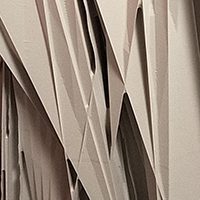Storrs Gallery to Present Tensional Topography

“The traditional role of architecture has been one of reassuring us that things are under our control, that is, stable and static. But it is quite another thing to think of all architecture ‘in tension.’”
– Lebbeus Woods, 2004
The School of Architecture and Storrs Gallery present a new exhibition, Tensional Topography, with an opening reception on Monday, March 13, from 5:30 to 7:00 pm. Featuring the work of Visiting Assistant Professor of Architecture Jeffrey Nesbit and graduate design assistant Andrew Beres, Tensional Topography uses digital technologies to expand upon the investigations of experimental architect Lebbeus Woods (1940-2012).
Famed for his extraordinary drawings and insightful writings that examined architecture through its complex relationships to physics, philosophy, politics, art, geometry, and history, Woods was not a licensed practicing architect, but a researcher, theorist, and educator. He taught at numerous institutions, ending his career at The Cooper Union in New York City, and in 1988 co-founded the Research Institute of Experimental Architecture. Fascinated in particular by the impact of natural and man-made forces, such as earthquakes or war, on the built environment, Woods’s work presents architecture in a state of tension and transformation, rather than a state of stability.
While Woods worked entirely in analog mediums and methods, creating drawings and models by hand, he acknowledged that the digital had become central to the practice – and the future – of architecture. Nesbit and Beres have used the digital to push Woods’s concepts even further, their sophisticated computations and experimentations producing a series of digitally fabricated prints, drawings, and models for the exhibition.
 Tensional Topography draws inspiration from two of Woods’s projects: his Terrain series (1999) of drawings, which, according to Woods, depict a “potentially infinite number of synthetic landscapes,” and The Storm (2002), an installation in the Houghton Gallery at Cooper Union that made “tension” visible in wall-sized drawings and an elaborate web of cables and rods stretched across the room. “By stringing cables and wooden rods as the material consequences of such dynamic interactions,” writes Nesbit in his project abstract, “the installation established a flexible and ever-changing system affected by its subsequent forces and disturbances in the environment.”
Tensional Topography draws inspiration from two of Woods’s projects: his Terrain series (1999) of drawings, which, according to Woods, depict a “potentially infinite number of synthetic landscapes,” and The Storm (2002), an installation in the Houghton Gallery at Cooper Union that made “tension” visible in wall-sized drawings and an elaborate web of cables and rods stretched across the room. “By stringing cables and wooden rods as the material consequences of such dynamic interactions,” writes Nesbit in his project abstract, “the installation established a flexible and ever-changing system affected by its subsequent forces and disturbances in the environment.”
In the research and the products of Tensional Topography, Nesbit and Beres merge these two investigations, applying “the notion of interrelated forces to the generation of a so-called topographic, common ground,” writes Nesbit, in an attempt to “propel the work into an exploration of unpredictable design morphology.” Beginning with a digital representation of The Storm, they methodically altered the tension fields by removing lines or surfaces or volumes, resulting in radically different constructs (and thus beautifully varied images for the exhibition). They then expanded the volumes, digitally creating artificial landscapes, or topographies, which demonstrate a relationship to Woods’s Terrain and are strikingly rendered in both 2D and large-scale 3D formats.



The research of Tensional Topography has been conducted through Haeccietas Studio, the experimental architecture studio that Nesbit founded in 2010. The exhibition will remain on view in Storrs Gallery through April 22.